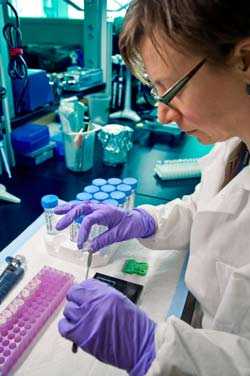Shiga Toxin-Producing E. coli & Food Safety
ALERT: Outbreak Linked to E.coli
CDC, FDA, and several states are investigating an outbreak of E. coli infections linked to I.M. Healthy Brand SoyNut Butter. If you have any recalled products in your home, throw them away. Learn more about the recall and read our advice to consumers.

Although most kinds of E. coli are harmless, others can make you sick. Learn about E. coli and what you can do to help lower your chances of infection.
What are Escherichia coli?
Escherichia coli (abbreviated as E. coli) are bacteria found in the environment, foods, and intestines of people and animals.
Most E. coli are harmless and are actually an important part of a healthy human intestinal tract. However, some E. coli can cause diarrhea, urinary tract infections, respiratory illness, bloodstream infections, and other illnesses. The types of E. coli that can cause illness can be transmitted through contaminated water or food, or through contact with animals or people.
What are Shiga toxin-producing E. coli?
Some kinds of E. coli bacteria cause disease when they make a toxin called Shiga toxin. The bacteria that make these toxins are called “Shiga toxin-producing E. coli,” or STEC for short.
- The most common type of STEC in the United States is E.coli O157:H7 (often shortened to E. coli O157 or even just O157).
- Other STEC are called non-O157.
When you hear news reports about outbreaks of E. coli infections, they are usually talking about E. coli O157.
CDC estimates that each year STEC causes 265,000 illness, 3,600 hospitalizations and 30 deaths in the United States.
Who gets STEC infections?
People of any age can become sick from STEC. Children younger than 5 years of age and older adults are more likely than others to develop serious illness and a life-threatening complication called hemolytic uremic syndrome (HUS). However, even healthy children and adults of any age can become seriously ill.
What are the symptoms of STEC infections?
The symptoms of STEC infections vary for each person but often include very bad stomach cramps, diarrhea (often bloody), and vomiting. If there is fever, it usually is less than 101˚F. Most people get better within 5–7 days. Some infections can be very mild, but others can be life-threatening.
Contact your healthcare provider if you have diarrhea that lasts for more than 3 days or is accompanied by high fever, blood in the stool, or so much vomiting that you cannot keep liquids down and you pass very little urine.
Did You Know?

Newer and faster diagnostic technology called culture independent diagnostic tests (CIDTs) helps doctors diagnose non-O157 STEC infections.
However, CIDTs present some challenges. CIDTS may affect our ability to find and prevent foodborne illness outbreaks and track foodborne illness trends. Learn more >

Problem: One in four burgers turns brown before it has reached the safe internal temperature of 160°F (according to USDA Color of Cooked Ground Beef as It Relates to Doneness).
Solution: Use a food thermometer.
What are the complications of STEC infections?
Around 5–10% of people diagnosed with E. coli O157 infection develop a potentially life-threatening complication known as hemolytic uremic syndrome (HUS), a type of kidney failure. Signs that a person is developing HUS include:
- urinating less often
- feeling very tired
- losing pink color in cheeks and inside the lower eyelids
People with HUS should be hospitalized because their kidneys may stop working and they may develop other serious problems. Most people with HUS recover within a few weeks, but some suffer permanent health problems or die.
How can I prevent a STEC infection?
- Know your chances of getting food poisoning. People with higher chances for foodborne illness are pregnant women, newborns, children, older adults, and those with weak immune systems, such as people with cancer, diabetes, or HIV/AIDS.
- Practice proper hygiene, especially good handwashing.
- Wash your hands thoroughly after using the bathroom and changing diapers.
- Wash your hands thoroughly before and after preparing or eating food.
- Wash your hands thoroughly after contact with animals or their environments (at farms, petting zoos, fairs, even your own backyard).
- Wash your hands thoroughly before preparing and feeding bottles or foods to an infant or toddler, before touching an infant or toddler’s mouth, and before touching pacifiers or other things that go into an infant or toddler’s mouth.
- Keep all objects that enter infants’ and toddlers’ mouths (such as pacifiers and teethers) clean.
- If soap and water aren’t available, use an alcohol-based hand sanitizer with at least 60% alcohol (check the product label to be sure). These alcohol-based products can quickly reduce the number of germs on hands in some situations, but they are not a substitute for washing with soap and running water.
- Follow the four steps to food safety when preparing food: clean, separate, cook, and chill.
- Cook meats thoroughly:
- To kill harmful germs, cook beef steaks and roasts to an internal temperature of at least 145°F (62.6˚C) and allow to rest for 3 minutes after you remove meat from the grill or stove.
- Cook ground beef and pork to a minimum internal temperature of 160°F (70˚C).
- Always use a food thermometer to check that the meat has reached a safe internal temperature because you can’t tell whether meat is safely cooked by looking at its color.
- Don’t cause cross-contamination in food preparation areas. Thoroughly wash hands, counters, cutting boards, and utensils after they touch raw meat.
- Avoid raw milk, unpasteurized dairy products, and unpasteurized juices (such as fresh apple cider).
- Don’t swallow water when swimming and when playing in lakes, ponds, streams, swimming pools, and backyard “kiddie” pools.
More Information
- Page last reviewed: May 5, 2017
- Page last updated: May 5, 2017
- Content source:
- National Center for Emerging and Zoonotic Infectious Diseases
- Page maintained by: Office of the Associate Director for Communication, Digital Media Branch, Division of Public Affairs




 ShareCompartir
ShareCompartir